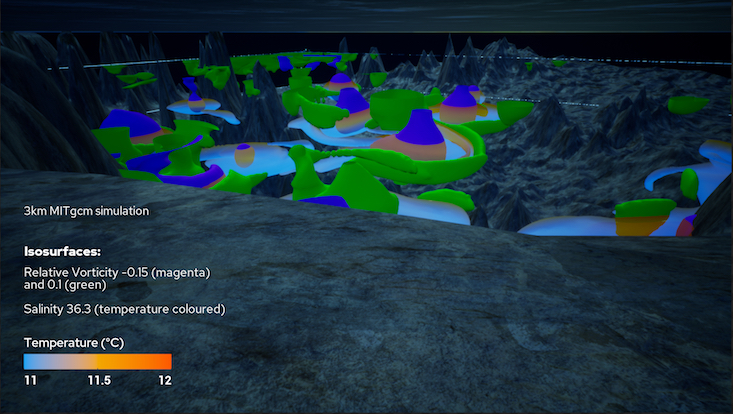Meddies visualized with the Unreal Engine - Preview
This video is a preview for an interactive, real-time Unreal Engine environment that will feature the one year evolution of a 3km MITgcm simulation with daily time resolution. The introductory part was rendered with Sequencer (the cinematic renderer of the Unreal Engine), followed by two game-mode live recordings of environment walk-throughs. The project technical details can be found below the video.
Simulation description:
Eddies enclose warm and salty Mediterranean water
The high rate of evaporation in the Mediterranean Sea leads to a significantly large salinity in that basin when compared with the Atlantic. The salty and relatively warm Mediterranean Water flows through the Strait of Gibraltar and afterwards along the Iberian Peninsula into the northeast Atlantic. At an intermediate depth (800-1200m), it flows over a complex system of underwater canyons and promontories. In the course of this, strong eddies separate from the main flow and spread into the ocean interior.
The film shows the Mediterranean Water eddies (meddies for short) wandering through the ocean (violet/blue) while rotating clockwise and enclosing the salty and warm water, keeping it over several years. During their movement, the meddies are influenced by other oceanic eddies (shown in green), whose rotation sense is counterclockwise. Due to the interaction, the meddies modify their translation direction, sometimes start to wobble and can eventually loose their stability and be destroyed.

Meddies in the Northeast Atlantic
Software development and scripting was done in C++ , VEX (the shading language of Houdini) and Blueprints (the visual scripting language of the Unreal Engine).
The following software and libraries were employed in the project workflow:
1. Houdini FX was used for data preprocessing (removal of noisy small features, followed by feature-preserving mesh polygon reduction) and terrain procedural modelling and layering
2. Quixel Megascans was used for creating the physically-based texture materials
3. The UE4 Community Free Ocean Project libraries were used for creating the ocean surface with Gerstner waves
4. Unreal Engine 4 for setting up and rendering the real-time environment
